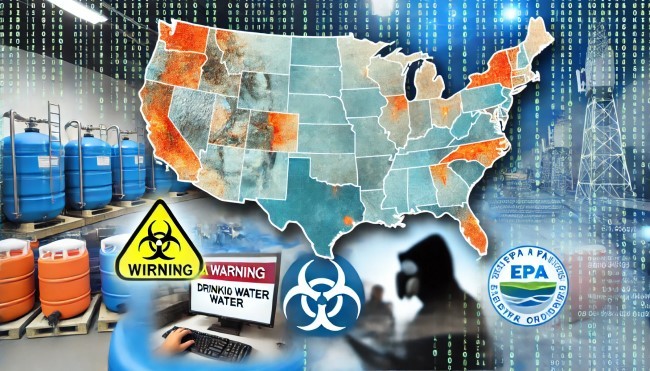Drinking Water Warning Issued Nationwide: A Critical Alert
EPA's Urgent Call to Action for Water Utilities

The Environmental Protection Agency (EPA) has issued a drinking water warning nationwide, highlighting severe cybersecurity vulnerabilities in community water systems. This alert comes as an urgent reminder for water utilities to fortify their defenses against a rising wave of cyberattacks that threaten the safety and reliability of the nation’s drinking water supply.
The EPA has issued a drinking water warning nationwide, urging water utilities to strengthen their cybersecurity measures immediately. Recent inspections revealed that 70% of water systems have critical vulnerabilities, including default passwords and outdated systems, making them susceptible to cyberattacks. The alert highlights significant risks posed by state-affiliated cyber groups from China, Russia, and Iran, emphasizing the need for immediate action to protect public health.
Introduction
The recent drinking water warning issued nationwide by the EPA underscores the pressing need for improved cybersecurity in water utilities across the United States. With the rising incidence of cyberattacks targeting critical infrastructure, this warning serves as a crucial reminder of the vulnerabilities within our water systems and the potential consequences for public health.
The Nationwide Drinking Water Warning
Overview of the Alert
On August 7, 2024, the EPA issued a drinking water warning nationwide, urging all water utilities to take immediate action to protect their systems from cyber threats. The alert followed a series of inspections revealing that a significant number of water systems fail to meet the security standards set by the Safe Drinking Water Act.
Specific Vulnerabilities Identified
The EPA’s inspections identified several critical vulnerabilities within the nation’s water systems. These include the use of default passwords, single logins that can easily be compromised, and outdated software that lacks necessary security updates. These weaknesses make water utilities prime targets for cyberattacks.
Recent Cyberattacks on Water Systems
Examples of Cyberattacks
The warning issued by the EPA also highlights recent cyberattacks that have targeted water systems across the country. For instance, in late 2023, an Iranian-linked group known as “Cyber Av3ngers” targeted a small town’s water provider in Pennsylvania. Similarly, earlier this year, a Russian-linked group attempted to disrupt several Texas water utilities.
Impact of Cyberattacks
Cyberattacks on water systems can have severe consequences, including the disruption of water treatment processes, damage to pumps and valves, and the alteration of chemical levels to hazardous amounts. These incidents underscore the critical need for enhanced cybersecurity measures to protect public health and safety.
The EPA’s Response and Recommendations
Increased Inspections and Training
In response to the rising threats, the EPA has announced plans to increase the number of inspections and offer free training to help water utilities address their cybersecurity vulnerabilities. The agency emphasizes the importance of conducting thorough risk assessments and developing robust cybersecurity plans.
Federal Support and Funding
Given the resource constraints faced by many water utilities, especially smaller ones, the EPA is advocating for substantial federal funding to support the implementation of necessary cybersecurity measures. This funding is essential to ensure that all communities can access safe and secure drinking water.
The Broader Implications
Nationwide Impact
The drinking water warning issued nationwide has significant implications for public health and safety. As water is a critical lifeline infrastructure, any disruption caused by cyberattacks can have widespread consequences, affecting millions of people across the country.
The Role of State-Affiliated Groups
The involvement of state-affiliated cyber groups from countries like China, Russia, and Iran further complicates the threat landscape. These groups often have sophisticated capabilities and can launch coordinated attacks that disrupt multiple water systems simultaneously.
Case Studies: Drinking Water Warnings in Specific States
Drinking Water Warning Issued Nationwide Today
The drinking water warning issued nationwide today serves as a stark reminder of the ongoing threats to our water systems. The EPA’s alert calls for immediate action to secure these systems against cyberattacks and protect public health.
Drinking Water Warning Issued Nationwide Map
To better understand the scope of the vulnerabilities, the EPA has released a drinking water warning issued nationwide map. This map highlights the regions most at risk and the specific water systems that require urgent attention.
EPA Issues Nationwide Drinking Water Warning to Water Utilities
In its official communication, the EPA emphasizes the critical need for water utilities to address their cybersecurity vulnerabilities. The agency’s warning outlines specific actions that utilities must take to comply with the Safe Drinking Water Act and protect their systems from cyber threats.
Drinking Water Warning Issued Nationwide Texas
Texas has been identified as one of the states with significant vulnerabilities in its water systems. The recent cyberattacks on Texas utilities underscore the urgent need for enhanced security measures and federal support to protect the state’s drinking water supply.
Conclusion
The drinking water warning issued nationwide by the EPA is a critical call to action for water utilities across the United States. With the rising incidence of cyberattacks targeting essential infrastructure, it is imperative that all water systems implement robust cybersecurity measures to protect public health and ensure the safety and reliability of our nation’s drinking water supply. The collaborative efforts of federal agencies, state governments, and local utilities are essential to address these vulnerabilities and safeguard our water systems for the future.



